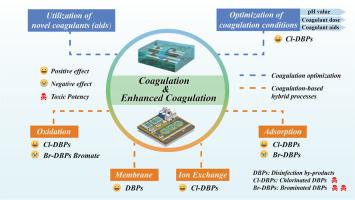Advances in Colloid and Interface Science ( IF 15.6 ) Pub Date : 2021-08-31 , DOI: 10.1016/j.cis.2021.102518 Pin Wang 1 , Shunke Ding 1 , Rong Xiao 1 , Guangyu An 2 , Chao Fang 1 , Wenhai Chu 1

|
The unintended formation of disinfection by-products (DBPs) has received considerable attention as it may pose risks to human health. Coagulation is the most common process for removing particulates as well as dissolved organic matter (DOM) (i.e., DBP precursors) during drinking water and wastewater treatments. With the improvement of water quality standards and the increased fluctuation in source water quality, conventional coagulation becomes challenging. Thus, significant efforts have been made to enhance coagulation to promote the removal of DOM in source water and mitigate the formation of DBPs in drinking water. This review provides a brief summary of the properties of DBP precursors and summarizes the effectiveness of enhanced coagulation involving three types of coagulants (metal-based coagulants, organic polymers, and organic-inorganic hybrid coagulants) in controlling the formation of DBPs during chlor(am)ination disinfection. Metal-based coagulants can achieve a reduction in DBP formation potential of approximately 20%–60% in natural water under enhanced coagulation conditions. Both the organic polymers (used as coagulant aids) and novel hybrid coagulants increase the removal of DOM and exhibit high potential for mitigating DBP formation. In addition, integrated treatments combining coagulation with other treatment processes (e.g., oxidation, membrane filtration, ion exchange, and adsorption) to enhance DBP precursor removal are evaluated in terms of performance, mechanisms, and features. Advanced treatments, such as membrane filtration and activated carbon adsorption, are effective coagulation-assisted processes, and can further control chlorinated DBPs; however, the elevated formation of bromate or highly brominated DBPs is of particular concern.
中文翻译:

增强凝结以减轻消毒副产物前体:综述
消毒副产物 (DBP) 的意外形成已受到相当多的关注,因为它可能对人类健康构成威胁。混凝是在饮用水和废水处理过程中去除微粒和溶解有机物 (DOM)(即 DBP 前体)的最常见过程。随着水质标准的提高和源水水质波动的加剧,常规混凝变得具有挑战性。因此,已做出重大努力来增强混凝以促进源水中 DOM 的去除并减轻饮用水中 DBP 的形成。本综述简要总结了 DBP 前体的特性,并总结了涉及三种类型混凝剂(金属基混凝剂、有机聚合物、是) 消毒。在增强混凝条件下,金属混凝剂可使天然水中的 DBP 形成潜力降低约 20%–60%。有机聚合物(用作助凝剂)和新型混合混凝剂都可以增加 DOM 的去除率,并表现出减轻 DBP 形成的巨大潜力。此外,还评估了将混凝与其他处理过程(例如,氧化、膜过滤、离子交换和吸附)相结合以增强 DBP 前体去除的综合处理的性能、机制和特征。膜过滤和活性炭吸附等高级处理是有效的混凝辅助工艺,可以进一步控制氯化DBPs;然而,



























 京公网安备 11010802027423号
京公网安备 11010802027423号